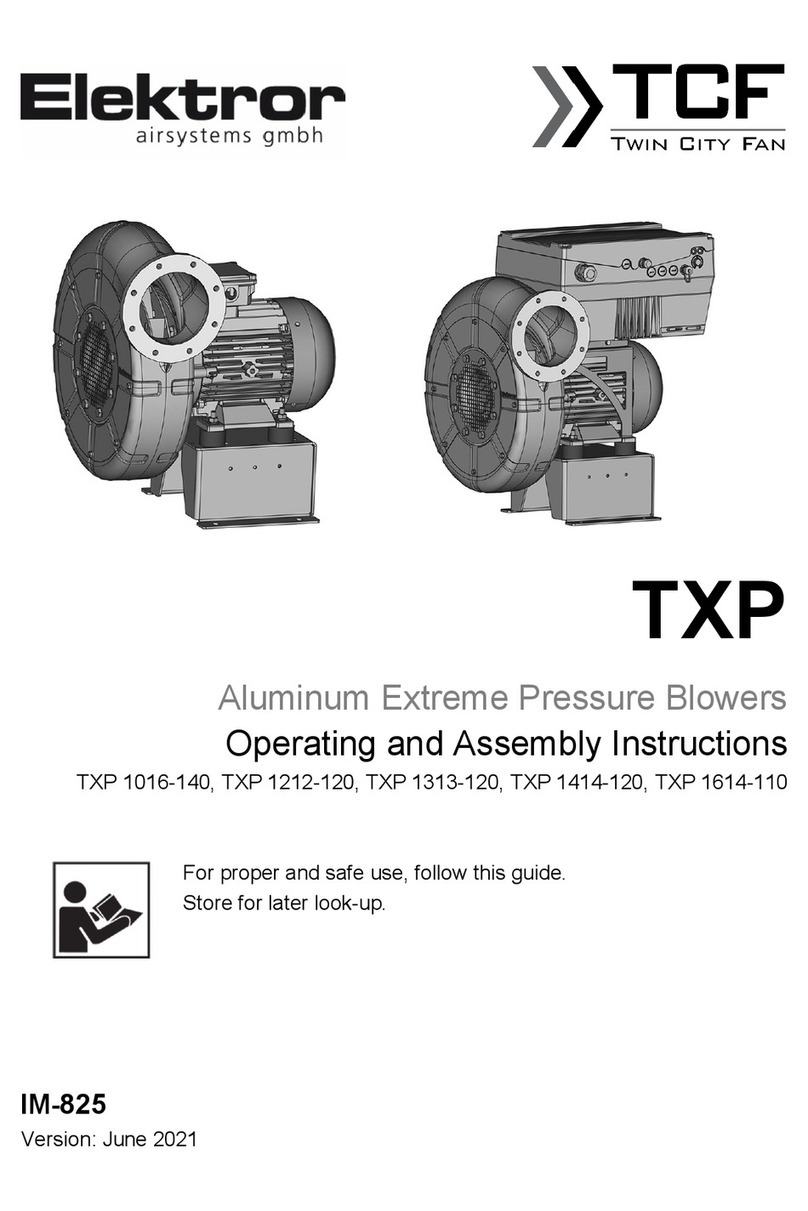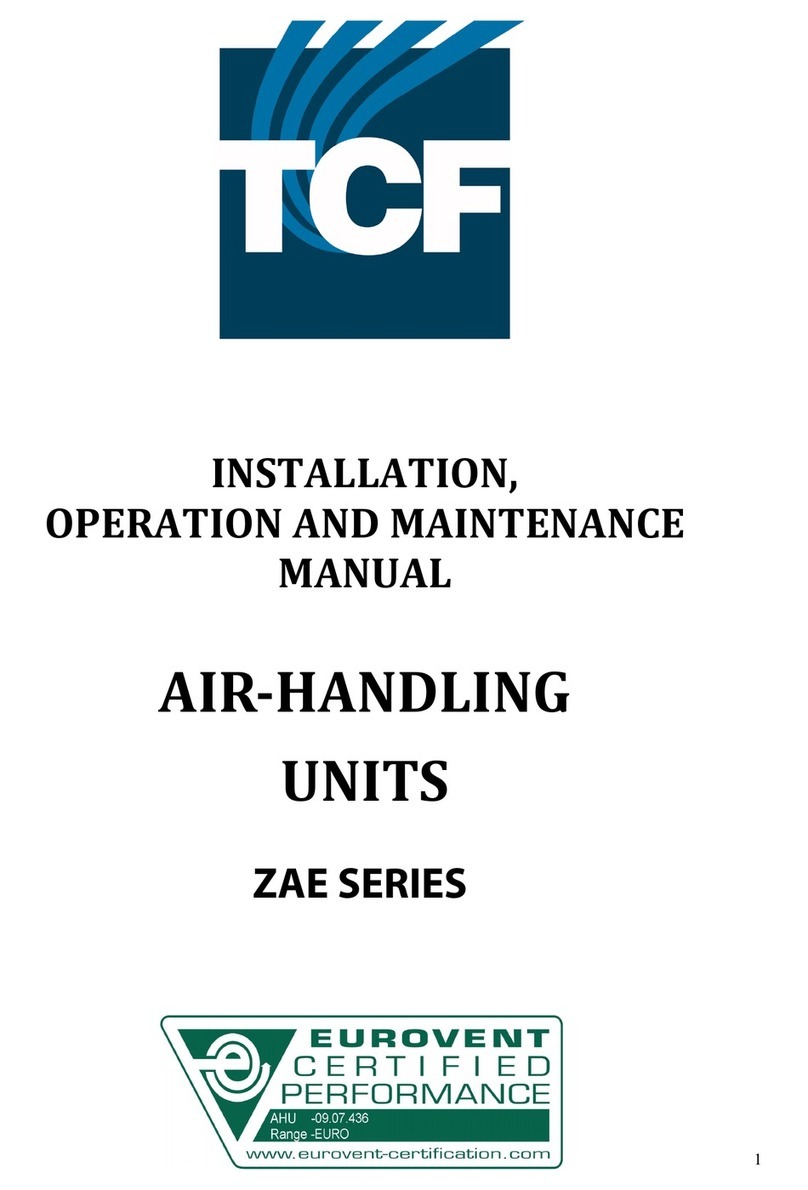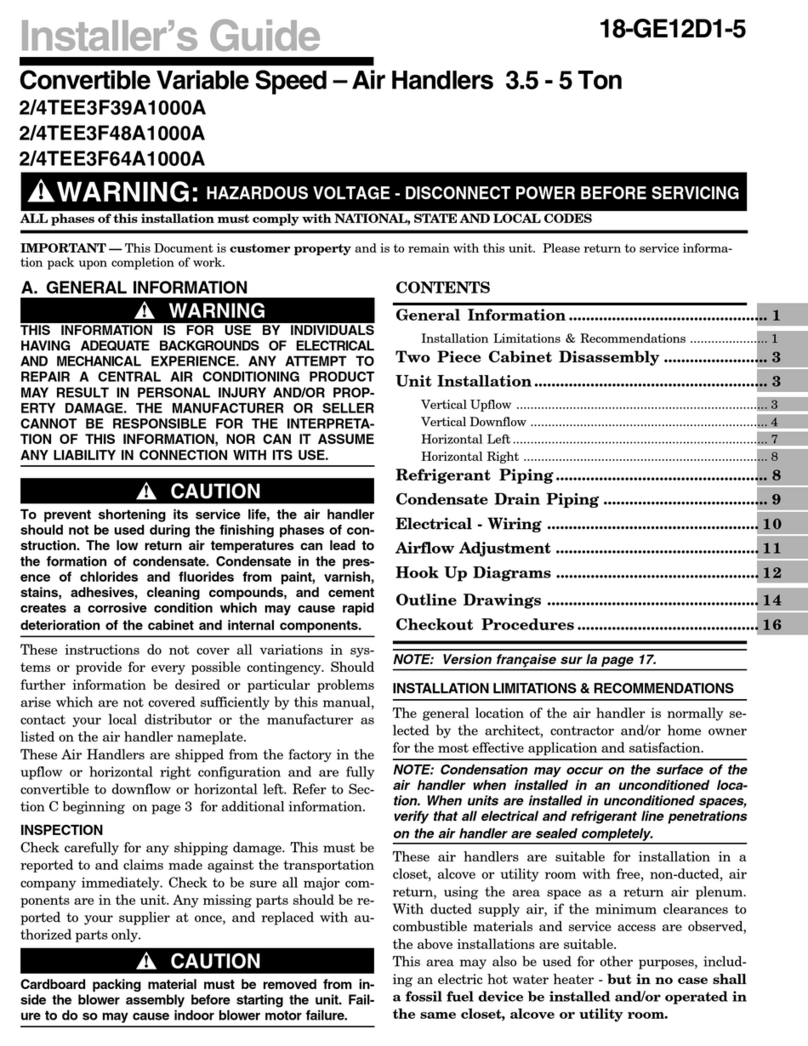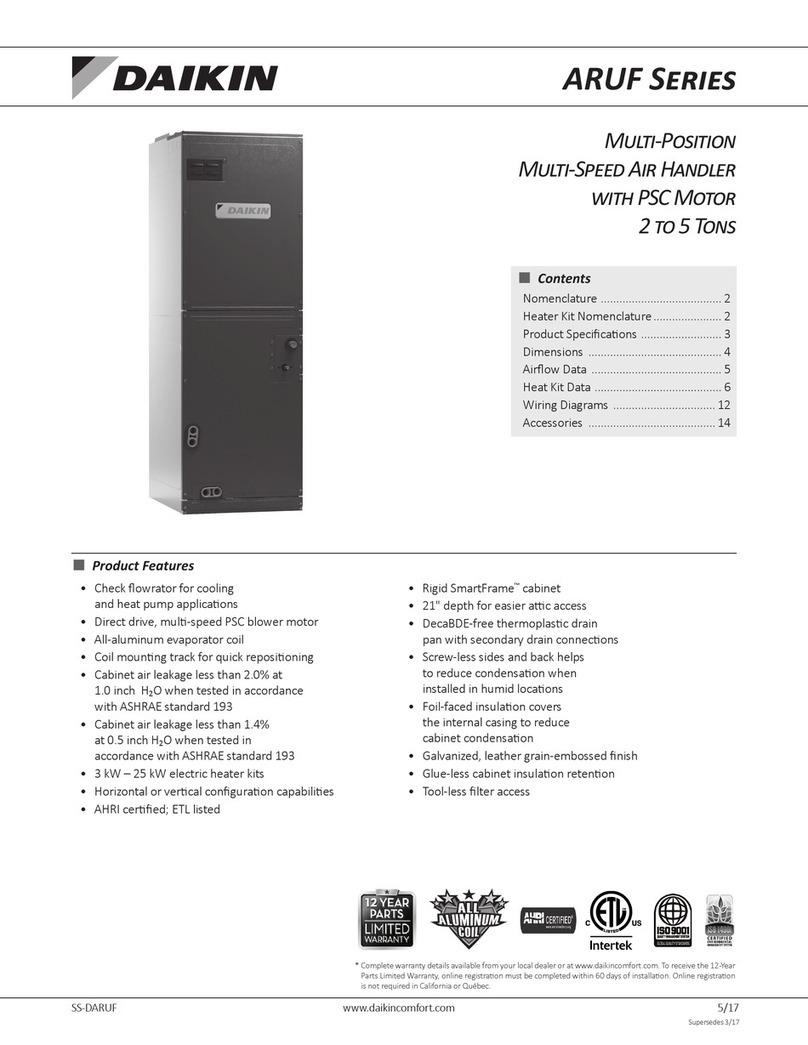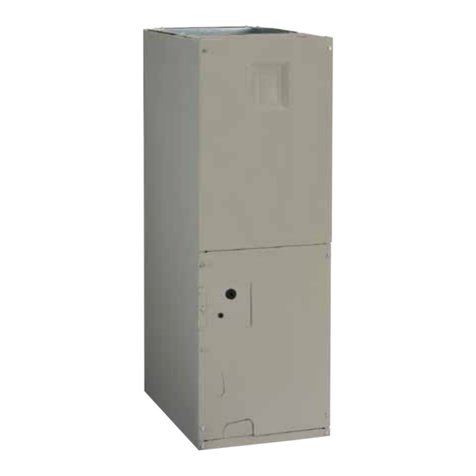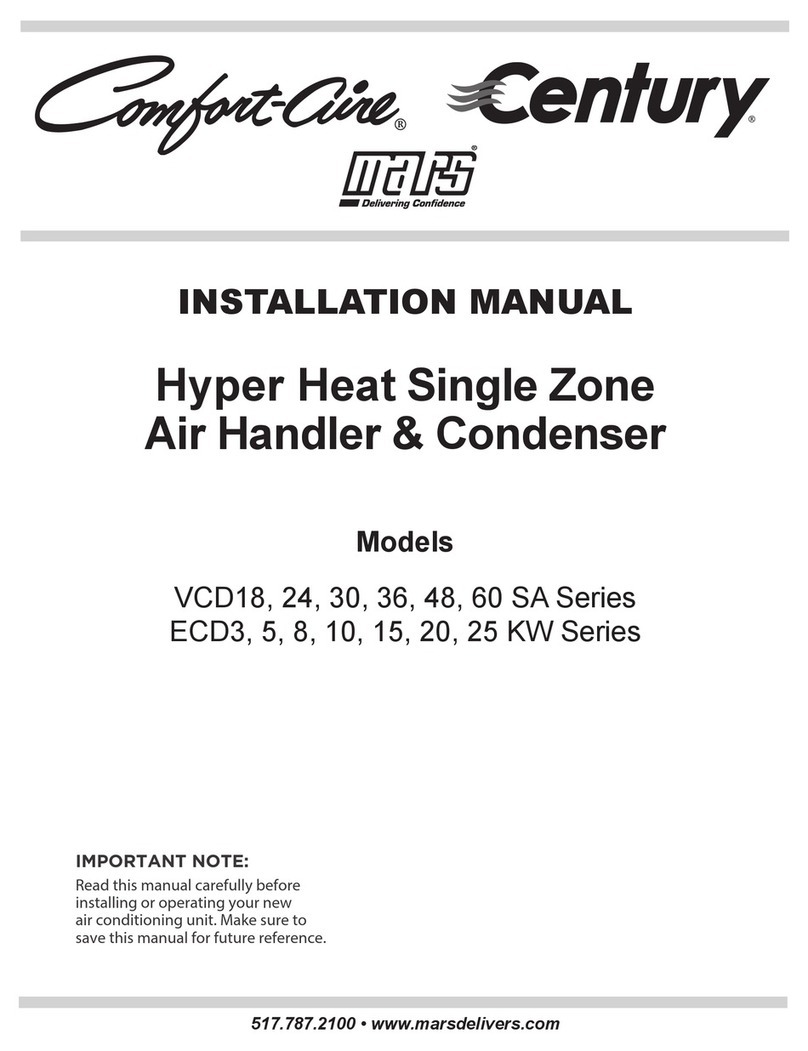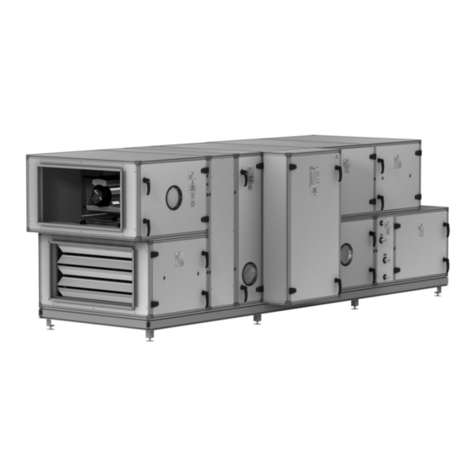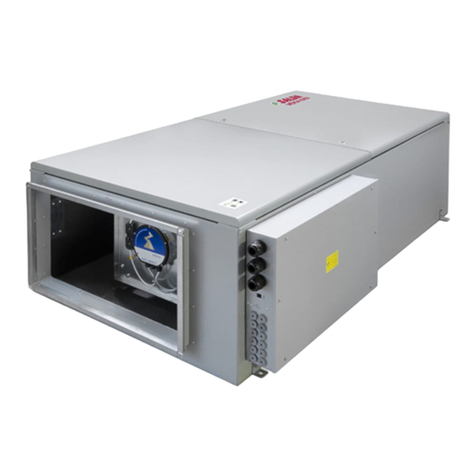TCF CV Series Operation and maintenance manual

INSTRUCTIONS, OPERATION
AND MAINTENANCE MANUAL
AIR EXHAUST UNITS
SERIES CV-CVM-CVMI-EV

TCF Termoventilatori Condizionatori Felsinea Srl
40057 Cadriano di Granarolo Emilia (Bologna), via Giuseppe di Vittorio 5
www.tcf.it
1
GENERAL INDEX
0. INTRODUCTION 2
1. DESCRIPTION OF THE EXHAUST AIR 2
UNIT
1.1 COMPOSITION 2
1.2 PERMITTED USE 2
2. CONTROL,PACKING,TRANSPORTATION
2.1 FACTORY INSPECTION OF THE SUPPLY 2
2.2 PACKING 2
2.3 LOADING,TRANSPORT,UNLOADING 2
3. PRESERVATION AND ASSEMBLY 3
ON SITE
3.1 POST-TRANSPORTATION CHECK 3
3.2 PRESERVATION ON SITE 3
3.3 POSITIONING 3
3.3.1 Base rame 3
3.3.2 Vibration damping 3
4. CONNECTION TO SYSTEMS AND START-UP
4.1 CONNECTION TO DUCTS 4
4.2 3-PHASE FAN MOTOR ASSEMBLY 4
CV MODELS
4.2.1 Electric motors 4
4.2.1.1 Connection or direct starting 4
4.2.1.2 Connection or star-delta starting 4
4.2.1.3 Dual speed three-phase motor 4
4.2.1.4 Permitted start-up time 5
4.2.1.5 Connection and protection accessories 5
4.2.2 Fan 5
4.2.3. Transmission 5
4.3 1-PHASE FAN MOTOR ASSEMBLY 6
CVM, CVMI, EV MODELS
4.3.1 Electric motors 6
4.3.1.1 3-speed ans 6
4.3.1.2 Single-speed ans 6
. MAINTENANCE 6
5.1 FOREWORD 6
5.2 FAN SECTION 7
5.2.1 Fan 7
5.2.2 Motor 7
5.2.3 Transmission (CV models) 7
5.2.3.1 Determining belt tension 7
5.2.3.2 Replacement o driving belt 8
5.2.3.3 Drive with multiple-race pulleys 8
5.3 ACCESSORIES 8
5.3.1 Control dampers 8
5.3.2 Fresh air inlet grilles 8
5.4 TROUBLESHOOTING 8
5.4.1 Reduction in low rate 8
5.4.2 Increase in low rate 8
5.5.3 Abnormal noise level 9
6. SAFETY 9
6.1 SAFETY-RELATED FEATURES OF 9
AIR-EXHAUST UNITS
6.2 SAFETY NOTICES APPLIED TO THE 9
UNITS
6.3 PRACTICAL ACCIDENT-PREVENTION 9
TIPS
7. WARRANTY 9

TCF Termoventilatori Condizionatori Felsinea Srl
40057 Cadriano di Granarolo Emilia (Bologna), via Giuseppe di Vittorio 5
www.tcf.it
2
0. INTRODUCTION
This manual has been compiled by TCF Srl to provide the
installer, customer and user with instructions intended to
ensure the proper management and use o the air-exhaust
units series CV, CVM, CVMI, EV rom the delivery up to the
commissioning.
The recommendations which ollow are intended to ensure a
continuous and durative operating li e o the air exhaust unit.
The procedures described below should be per ormed by
skilled personnel with a good knowledge o air-conditioning
systems design and operation, even though, thanks to the
unit’s simplicity o design, these could be carried out also by
those un amiliar with air handling.
1. DESCRIPTION OF THE AIR-EXHAUST UNIT
1.1 COMPOSITION
The air exhaust unit is made up rom:
•Return section possibly including one control
damper or grille
•Fan section
1.2 PERMITTED USE
TCF air exhaust units are designed exclusively or CIVIL AND
INDUSTRIAL AIR TREATMENT.
In case o CORROSIVE and/or EXPLOSIVE air lows, a number
o special technical modi ications must be made at the design
stage which, altogether, adapt the machine or the treatment
o special air lows.
The air exhaust units must at all times be used strictly in
accordance with the design conditions established at the time
o contract in agreement with the customer. ANY OTHER USE
SHALL CONSTITUTE IMPROPER USE AND IS THEREFORE
DANGEROUS. THE MANUFACTURER MAY NOT BE HELD
LIABLE FOR DAMAGE CAUSED BY NON-STANDARD USE OR
ANY USE NOT ENVISAGED IN THE CONTRACT.
2. CONTROL, PACKING, TRANSPORTATION
2.1 FACTORY INSPECTION OF THE SUPPLY
Prior to shipping, each TCF air exhaust unit is subject to all
the unctional tests listed on the attached UNIT INSPECTION
SHEET. The controls concern:
•General machine dimensions
•Correct assembly o the various parts and sections
•Compliance with the various sa ety rules in orce
•Integrity o all the system’s component parts
•Application o the identi ication, operation and
sa ety notices
On completion o the inspection, the Chie Inspector applies
the EC mark demonstrating product compliance with
prevailing European Union machine directives.
2.2 PACKING
Transportation o the machines may be:
-normal
-special
In the ormer case, TCF Srl does not normally pack the units.
In case o special transportation, the packing requested is
agreed at the time o contract and is entirely on the
customer’s charge.
Fragile components supplied separate rom the unit, such as
control boards etc., are always delivered packed.
2.3 LOADING,TRANSPORT,UNLOADING
TCF Srl disclaims any liability or damage occurred to the air
exhaust unit during loading, unloading and transportation.
We there ore recommend that precautions be taken,
including:
-The load must be irmly secured to ensure its
integrity during transportation
-Handling must be per ormed without exerting orce
on protruding accessories (hydraulic attachments,
handles, hinges, air locks, protection roo )
-Do not overturn the sections as you may otherwise
break internal supports, components and dampers
-Do not subject the unit to violent impacts as you
may damage its integrity
-I a orkli t truck is used during the loading,
unloading and handling operations, the orks o the
truck must be at least the same length as the unit to
ensure stability ( ig. 1)
-I the air exhaust unit is itted with a continuous
steel base rame, handling may be carried out with a
crane, using cables irmly secured to rods (su icient
or the stress involved) passing through the holes
provided in the base.
I a crane is used, proceed as shown in the illustration,
using spacers to protect the structure ( ig. 2).
-During transportation, protect the unit rom
atmospheric agents. Special care must be taken i
the unit is supplied disassembled or designed or
internal use.

TCF Termoventilatori Condizionatori Felsinea Srl
40057 Cadriano di Granarolo Emilia (Bologna), via Giuseppe di Vittorio 5
www.tcf.it
3
3. ASSEMBLY ON SITE
3.1 POST-TRANSPORTATION CHECK
Upon arrival o the air exhaust unit on site, TCF suggests the
customers to per orm an accurate check o the structure and
o the components.
Should any transportation damage be detected, this must be
noti ied on the delivery bill. The carrier must immediately ile
a report o the accident to obtain compensation rom the
insurance company.
3.2 PRESERVATION ON SITE
In order to keep the air exhaust unit in good and e icient
condition on site, the ollowing steps must be taken irst:
-prior to installation, position the unit and the
accessories in a place o ering the best possible
protection against accidental knocks, dust and
atmospheric agents
-care ully cover the inlets and outlets to prevent
oreign matter rom entering the unit and damaging
the internal components
3.3 POSITIONING
3.3.2 Base rame
The permanent installation o the air exhaust unit may be
made:
-directly on the loor ( ig. 3a)
-on a concrete bed ( ig. 3b)
-on a steel section bed ( ig. 3c)
-on a suspended base ( ig. 3d)
Both the loor and the beds must be capable o withstanding
the machine weight to within the required sa ety margins.
The air exhaust unit must be positioned on a horizontal
sur ace so as to prevent:
-damage to the an motor units caused by uneven
weights on the vibration dampers
-di iculty in opening and closing the inspection
doors
The horizontal alignment o the support sur ace must be
checked with a SPIRIT LEVEL; adjustments may be made
using STEEL SHIMS.
FIG. 3
3.3.2 VIBRATION DAMPING
In order to ensure e ective protection against vibrations, the
air exhaust unit must be installed as ollows:
-suitable DAMPERS must be placed between the
machine and the support sur ace, in material
designed to withstand the weight involved
-the unit must not be astened directly with screws
but by means o brackets ( ig. 5)
Even in case o suspended installation o the unit, the
supports must not be screwed directly into the ceiling;
vibration damping material must always be placed between
the support and the ceiling ( ig. 5).

TCF Termoventilatori Condizionatori Felsinea Srl
40057 Cadriano di Granarolo Emilia (Bologna), via Giuseppe di Vittorio 5
www.tcf.it
4
FIG. 5
4. CONNECTION TO SYSTEMS AND START UPS
4.1 CONNECTION TO DUCTS
At the point o connection to the air ducts, the air exhaust
units have a smooth or a langed sur ace.
In order to optimise the connection with the ducts, you must:
-clean the connection edges between duct and unit
-it a seal to the langes in order to prevent air
in iltration
-tighten the connecting screws irmly
-treat the joint with silicone to enhance the seal
I the connection is made with rubber canvas joints, make
sure they are not tightened on assembly completion, so as to
prevent damage or the transmission o vibrations.
In order to ensure the tightness o the connections and the
integrity o the unit, the weight o the ducts must under no
circumstances bear down on the unit. The ducts must be
supported by BRACKETS.
4.2 3-PHASE FAN-MOTOR ASSEMBLY CV MODELS
4.2.1 Electric motors
Be ore starting up the unit:
-inspect the motor CONTROL BOARD and check that
the motor protection devices are sized or the
maximum amperage, corresponding to the rated
value on the plate.
-The TERMISTORS, i present, must not be connected
to the power supply line o the electric motors since
otherwise they would be damaged irreparably
(operating voltage 1V)
-Check that the MAINS SUPPLY VOLTAGE is suited to
that o the motors as indicated on the relevant
plates
4.2.1.1 Connection or direct starting
The simplest electric motor start-up system is obtained by
connecting the motor directly to the supply line. However,
this method has limitations due to the high start-up current
(pick-up); this type o start-up is recommended or power
ratings up to 5,5kW or which TCF installs, as standard, 4-
poles 220/380 V three-phase motors.
The wiring diagrams are shown in ig. 6.
FIG. 6
4.2.1.2 Connection with star-delta starting
I the motor start-up current exceeds the value permitted by
the power supply, you may decide to choose or delta-star
starting.
For this purpose TCF installs dual voltage 400/690V motors
on its air exhaust units starting rom an output o 7,5kW, thus
allowing the motor to operate normally at 400V (delta
connection) and to start-up at 690V (star connection).
This arrangement reduces the starting current by
approximately 30% o the current involved in case o direct
starting.
FIG. 7
4.2.1.3 Dual speed three-phase motors
The diagram in ig. 8 shows the connection o a TWO-SPEED
MOTOR with two separate windings to the power supply.
TCF installs motors o this kind on the ollowing units:
-230/400V or power ratings up to 5,5kW
-400/690V or power ratings rom 7,5kW
This type o electric motor permits the delta-star connection
by means o a starter.

TCF Termoventilatori Condizionatori Felsinea Srl
40057 Cadriano di Granarolo Emilia (Bologna), via Giuseppe di Vittorio 5
www.tcf.it
5
The two-speed motors with a single DAHLANDER
commutable winding ( ig. 9) o er the advantage o
generating greater power than motors o the same size but
with separate windings.
4.2.1.4 Permitted start-up time
Because o the temperature increase, the start-up time o a
motor may not exceed the value shown in table 1.
The data re er to start-ups at exercise temperature, whereas
or cold start-ups such timings may be doubled.
4.2.1.5 Recommended connection and protection
accessories
For the sizing o cables and connections, please re er to the
motor nameplate data and to the laws in orce in the country
where the unit is installed.
FIG. 8
FIG. 9
4.2.2 Fan
Be ore start-up, carry out the ollowing checks:
-make sure that the an wheel is unctioning
correctly by rotating it manually
-check that any sa ety clamp, itted to prevent
damage during transportation, has been removed
rom the dampers ( ig. 10).
FIG. 10
sa ety clamps
4.2.3 Transmission
Be ore starting the air exhaust unit please check:
-the tension o the V-belts (section 5.2.3.1)
-that the pulleys are aligned (section 5.2.3.1)
-that the dowels, shown in ig. 20, in their possible
installation positions, are doing their unction o
securing the pulleys to the hubs

TCF Termoventilatori Condizionatori Felsinea Srl
40057 Cadriano di Granarolo Emilia (Bologna), via Giuseppe di Vittorio 5
www.tcf.it
6
FIG. 11
4.3 1-PHASE FAN MOTOR ASSEMBLY CVM, CVMI, EV
MODELS
4.3.1 Electric motors
Be ore starting up the unit:
-inspect the motor CONTROL BOARD and check that
the motor protection devices are sized or the
maximum amperage, corresponding to the rated
value on the plate.
-The thermal protections, i present, must not be
connected to the power supply line o the electric
motors since otherwise they would be damaged
irreparably
-Check that the MAINS SUPPLY VOLTAGE is suited to
that o the motors as indicated on the relevant
plates
4.3.1.1 3-speed ans
The scheme on ig. 12 shows the ‘code colour’ o the terminal
plate installed on the ans used or the EV and CVM series.
FIG. 12
WHITE ------------- COMMON
RED ------------- LOW SPEED
BLUE ------------- MEDIUM SPEED
BLACK ------------- HIGH SPEED
fan motor
STRIPED ___
I
I
I
PE
The scheme on ig. 13 shows the connection o a an motor
actuated by the 3-speed selector type ‘6990’.
FIG. 13
WHITE -------------------------------
6
RED -------------------------------
5
BLUE -------------------------------
4
BLACK -------------------------------
3
fan motor
STRIPED ___
___________ 2
I
I _____
1
commuter
I
I I
I
I I
PE N L
4.3.1.2 Single speed ans
The scheme on ig. 12 shows the ‘code colour’ o the terminal
plate installed on the ans used or the CVMI series.
FIG. 14
ORANGE
_________________
BLACK __________ I
STRIPED
___ I I
I I I
I I I
I I I
I I I
I I I
fan motor
PE N L
The scheme on ig. 15 shows the connection o a an motor
actuated by a “VVM” type speed controller.
FIG. 15
. MAINTENANCE
5.1 FOREWORD
TCF recommends that its customers carry out PREVENTIVE
MAINTENANCE on the air exhaust units in order to ensure a
long-term e iciency.
Such air exhaust units require little maintenance and have
been designed to make each operation as easy and sa e as
possible.

TCF Termoventilatori Condizionatori Felsinea Srl
40057 Cadriano di Granarolo Emilia (Bologna), via Giuseppe di Vittorio 5
www.tcf.it
7
5.2 FAN SECTION
5.2.1 Fan
In order to keep the an in per ect working order, WE
RECOMMEND YOU TO CHECK THE FOLLOWING AT LEAST
ONCE A MONTH:
-The cleanliness o the shell and wheel; remove any
deposits
-Damage and corrosion to the an components; in
case remedy with zinc-powder paint
-The tightness o the parts comprising the an section
-Seal o the vibration-damping joint itted to the an
supply mouth
-Cleaning and lubrication o any DAPO control air
locks. Lubrication o this part must be per ormed
every six months
-Absence o abnormal noises due to deterioration o
the bearings. I necessary, replace them. The ans
mounted on the TCF units are itted wither with
oilless
bearings
(design
lie
20.000 hours) or pedestal
bearings, depending on the operating conditions.
The pedestal bearings require periodic lubrication.
THE LUBRICATION INTERVALS show in table 2 are
subject to the environmental conditions and the
maximum temperature range during operation.
TABLE 2
Lubrication o an support bearings
5.2.2 Motor
In order to maintain the motor in per ect working order, TCF
recommends the FOLLOWING MONTHLY CHECKS:
-Cleanliness: remove any deposits
-Absence o abnormal noise due to deterioration o
the bearings
Power ul motors itted with grease nipples require
periodic lubrication. The greasing intervals, under
normal operating conditions, are shown in Table 3.
TABLE 3
Greasing o motor bearings
5.2.3 Transmission (CV models)
In order to ensure optimum drive e iciency and to avoid
damaging the an motor unit, the transmission must be kept
in per ect working conditions.
The ollowing must be CHECKED EVERY MONTH:
-The operating condition and dirtiness o the
transmission; remove any deposits
-Damage to the drive (cracks on belt and pulleys,
rayed belt edges, worn belts and pulleys). I
necessary, replace the damaged part(s)
-The per ect alignment o the transmission
-The tension o the belt (see section 5.2.3.1)
5.2.3.1 Determining belt tension
To alter the tension o the driving belts you must remove the
motor.
To acilitate this operation the motors are positioned on:
-guides
-belt-tensioning slides
in both cases it is easy to tighten or slacken the driving belt
by means o the lock nuts and adjusting screws.
In order to determine DRIVING BELT TENSION ( ig. 16), you
must:
-establish a centre distance (I) and block the drive
-using a spring-operated torque wrench, apply a
orce (P) on the midway point o the belt
(perpendicular to it) to obtain a de lection equal to
1/64 o the centre distance (approx. 16mm/m)
-check that the applied orce is within the values
indicated in table 5, i not, set a new centre distance
and repeat the test
TABLE 4

TCF Termoventilatori Condizionatori Felsinea Srl
40057 Cadriano di Granarolo Emilia (Bologna), via Giuseppe di Vittorio 5
www.tcf.it
8
FIG. 16
I the tension is not correct, the ollowing will occur:
-i the belt is slack, it will wear out rapidly and the
drive system will be ine icient
-i the belt is too tight, the motor and an bearings
will be damaged
whenever the belts are tightened, you must check that the
drive belts are aligned using an ordinary RULER ( ig. 17)
FIG.17
I the pulleys are o di erent thickness, you must check their
equivalence as shown in ig. 18 to ensure correct installation.
5.2.3.2 Replacement o driving belt
To REPLACE THE DRIVING “V” BELT:
-loosen the drive and remove the worn-out belt
-check the condition and wear o the pulleys and
replace them i necessary
-introduce the new belt without orcing; any orcing
could impair the transmission and shorten its
service li e
-align the drive and tension the belt
-check the belt tension a ter about 10 working hours
5.2.3.3 Drive with multiple-race pulleys
-in case o drives with several belts, the belts must be
replaced at the same time. This means that there
must not be belts presenting di erent states o wear
in the same transmission system
-the number o belts must always match the number
o races
-in this type o drive system, the belt slack must be
on the same side, as shown in ig. 19, be ore they are
tightened
FIG. 19
5.3 ACCESSORIES
5.3.1 Control dampers
The TCF control dampers o the SAL range do not require
particular maintenance. It is however recommended to veri y
the alignment o the gears and the smooth operation o the
ins. This could be damaged by the weight o ducts in case
they bear down o the dampers themselves, by de lecting
them (condition to be avoided).
5.3.2 Fresh air inlet grilles
They must requently be cleaned by deposits which obstruct
the air passage, jeopardizing the correct operation o the
whole installation.
5.4 TROUBLESHOOTING
The most common MALFUNCTIONS in air exhaust units are:
-reduced low rate
-increased low rate
-abnormal noise
5.4.1 Reduction in low rate
This is the result o an uncontrolled increase in resistance in
the aeraulic circuit which alters the an operating point.
The most requent causes are:
-blockage o the intake grille(s)
-ully or partially closed control air locks
-ine icient an motor unit drive
5.4.2 Increased low rate
I the sum o the resistances in the aeraulic circuits is less
than the value considered at the design stage, the most
common causes are:

TCF Termoventilatori Condizionatori Felsinea Srl
40057 Cadriano di Granarolo Emilia (Bologna), via Giuseppe di Vittorio 5
www.tcf.it
9
-incorrect setting o any mechanical low controls or
zone air locks
-open or partially closed inspection doors
5.4.3 Abnormal noise level
With regard to the an, the causes may be:
-worn-out or de ective bearings
-an o -balance
-oreign matter in the an wheel
With regard to the electric motor, the causes may be:
-worn-out or de ective bearings
-loose cooling an and/or an guard
-magnetic noise during requency reductions with
inverter (applications below 22Hz are not
recommended as a rule)
With regard to the drive system, the causes may be:
-slipping o belt
-worn belt
-misaligned pulleys
-pulley with play on key
in order to remedy the mal unctions listed above (and not the
entire air-conditioning system), CONSULT THE CHAPTER
RELATED TO THE MAINTENANCE (ch. 5) OR, IF THE
PROBLEM PERSISTS, CONTACT OUR TECHNICAL
DEPARTMENT.
6. SAFETY
6.1 SAFETY-RELATED FEATURES OF AIR EXHAUST
UNITS
TCF Srl has itted its air exhaust units with every possible
sa ety eature to prevent accidents, especially during start-up
and maintenance.
Some o the SAFETY FEATURES are listed below:
-INSPECTION DOORS THAT CAN ONLY BE OPENED
WITH A KEY are installed in the sections housing
rotating parts and drives
-the GRATES and HOUSINGS protecting rotating
parts and drives can only be removed with a key
-the outside o the structure has ROUNDED EDGES
-elimination o sharp-edged steel sheet parts inside
and outside o the unit
-use o SELF-TAPPING SCREWS WITH NON-
PROTUDING TIPS inside sections and panels
we always recommend to install, inside the an section, an
ELECTRIC ISOLATOR, which has the unction o preventing
the an-motor assembly rom getting started during
maintenance operations, thus jeopardising the sa ety o the
technician.
6.2 SAFETY NOTICES APPLIED TO THE EXHAUST
UNITS
The inspection doors o the air exhaust unit carry SAFETY
NOTICES drawing the operator’s attention to the danger
connected with moving parts and warning him to
disconnect the system power be ore opening the inspection
doors ( ig. 20).
FIG. 20
6.3 PRACTICAL ACCIDENT-PREVENTION TIPS
-Open the inspection doors only when the an is at a
standstill
-Be ore carrying out maintenance work on the an
motor unit, make sure that the motor cannot be
restarted by accident
-Be ore operating on the motor, make sure that it has
cooled down completely
-In order to protect your hands, use a lever to
remove the belts
-Block the an wheel be ore maintaining it, since
(especially when the belt is removed) the ‘updra t
e ect’ caused by the ducts could make it rotate and
cause injury
7. WARRANTY
TCF Srl guarantees its products or 12 months rom shipment
date.
The warranty covers the normal operation o the individual
components installed on our units, such as motors, ans, heat
exchangers, humidi iers and other parts.
It should be stressed that the warranty covers manu acturing
de ects in these parts, while their e iciency is categorically
excluded since this is determined by the characteristics o the
aeraulic and hydraulic systems and by the design, and does
not there ore all within our sphere o responsibility.
TCF there ore undertakes to replace any individual
component which mal unctions as rapidly as possible and
subject to stocks. The part should be sent ( reight costs pre-
paid) to our headquarters and the replacement part will be
sent ex-works.
Please note, too, that the warranty does not include the
service o our personnel or the replacement o the part on
site; this cost is entirely on the installer’s account.
On receipt o the returned material deemed to be de ective,
an inspection will be carried out to establish whether the part
reveals abnormalities justi ying application o the warranty.
I it is established that the de ect is due to external actors,
the replacement part will be charged to the customer.
It should urthermore be noted that the warranty shall not
apply in the case o tampering or in case the ailure is a
consequence o incorrect installation or connection.
On this behal , re erence will be made to the instructions
contained in this Installation, Operation and Maintenance
Manual which accompanies each o our machines.
TCF Srl

TCF Termoventilatori Condizionatori Felsinea Srl
40057 Cadriano di Granarolo Emilia (Bologna), via Giuseppe di Vittorio 5
www.tcf.it
10
This manual suits for next models
3
Table of contents
Other TCF Air Handler manuals
Popular Air Handler manuals by other brands

Swegon
Swegon WISE Parasol Zenith 600 Installation

York
York MA installation manual

BLAUBERG Ventilatoren
BLAUBERG Ventilatoren KOMFORT EC S 160 user manual
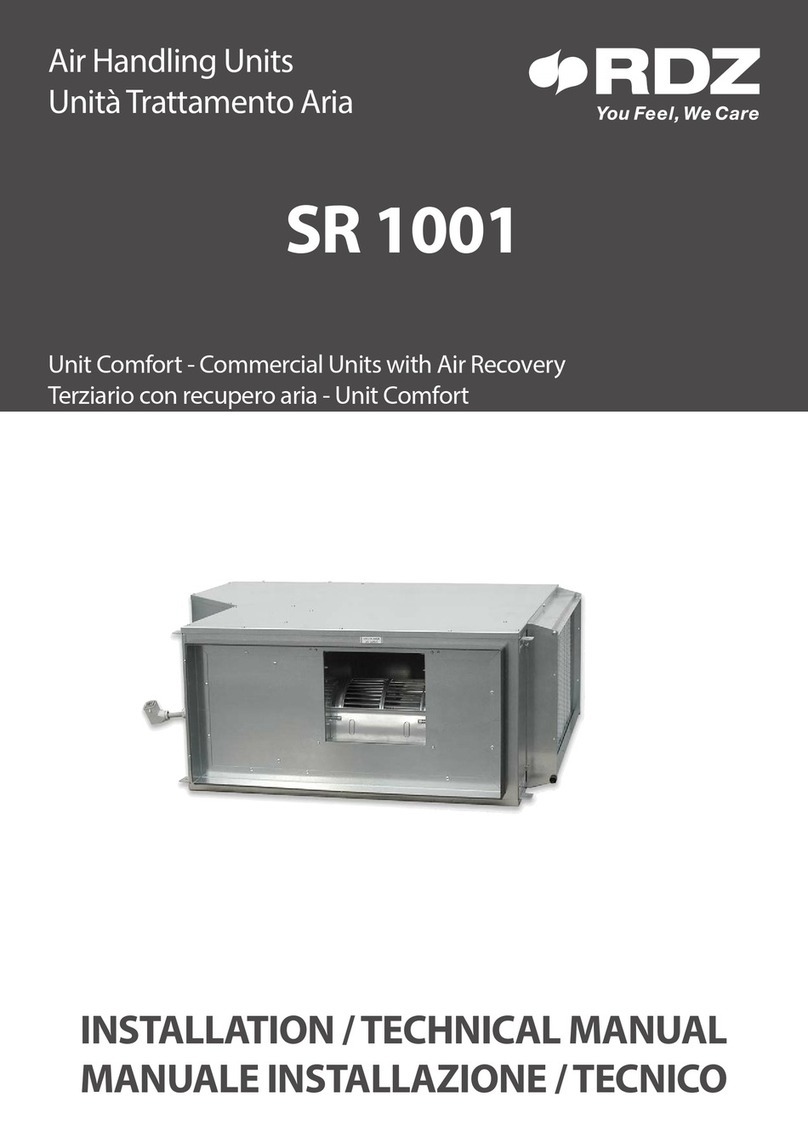
RDZ
RDZ SR 1001 Installation and technical manual

Amana
Amana PBH113G35CC installation instructions
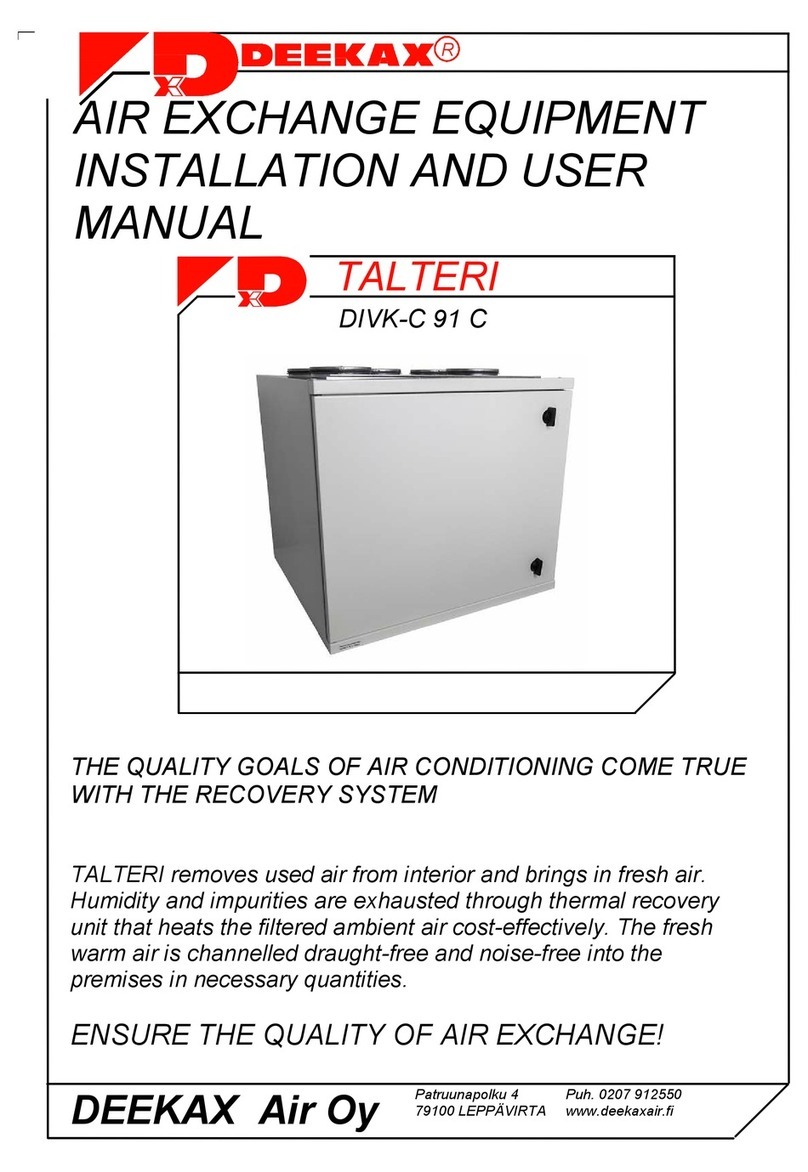
Deekax
Deekax TALTERI DIVK-C 91 C Installation and user manual
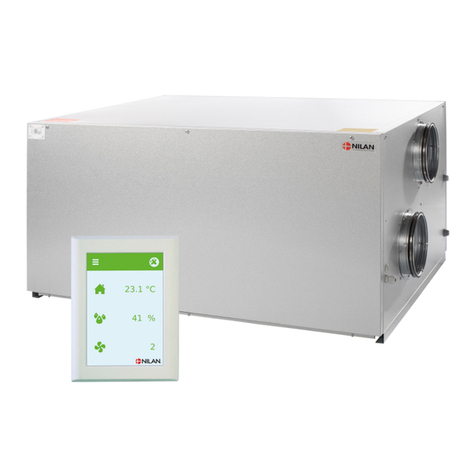
nilan
nilan Comfort 600 installation instructions
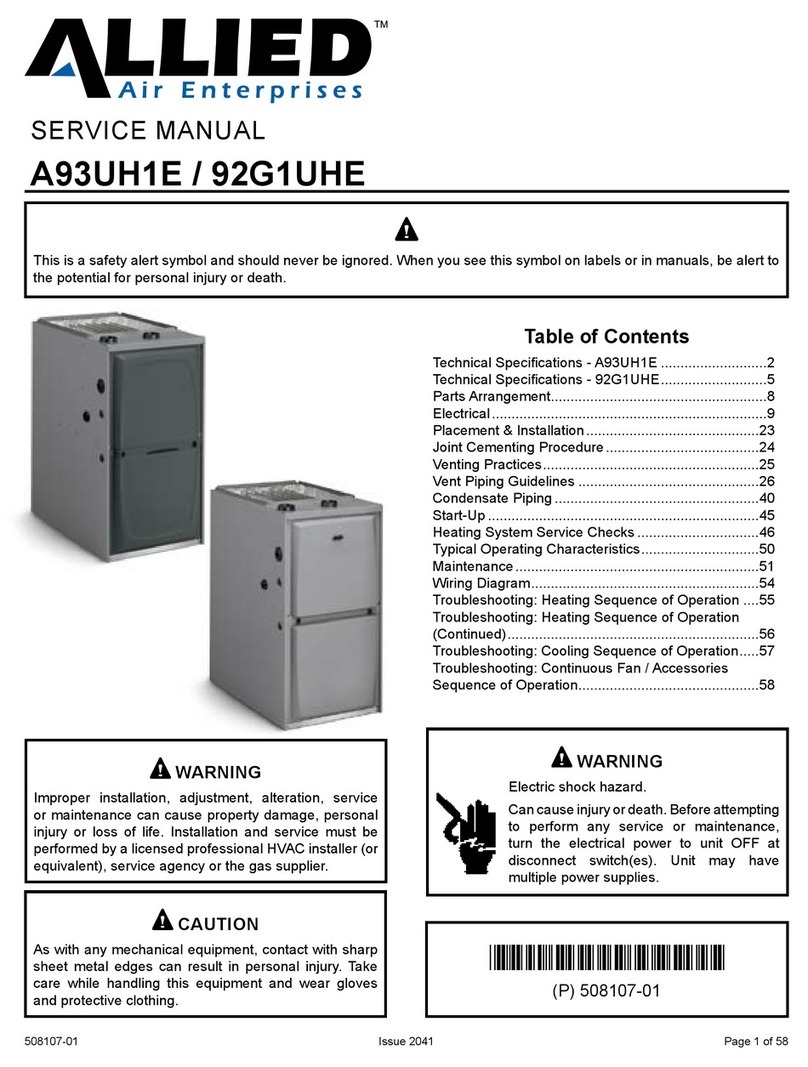
Allied
Allied A93UH1E Service manual
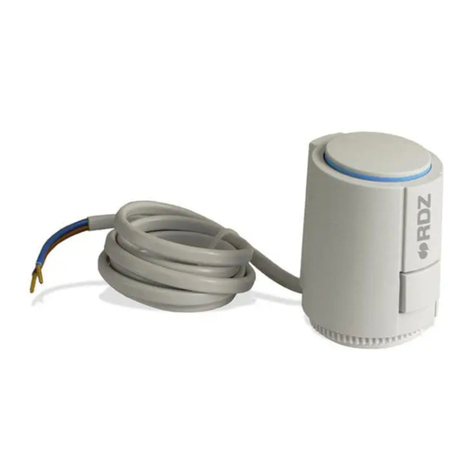
RDZ
RDZ 1057230 Technical sheet

BLAUBERG Ventilatoren
BLAUBERG Ventilatoren KOMFORT Ultra D 105-A Operation manual

AIR-TRANSFER
AIR-TRANSFER AT1200HBEC user manual
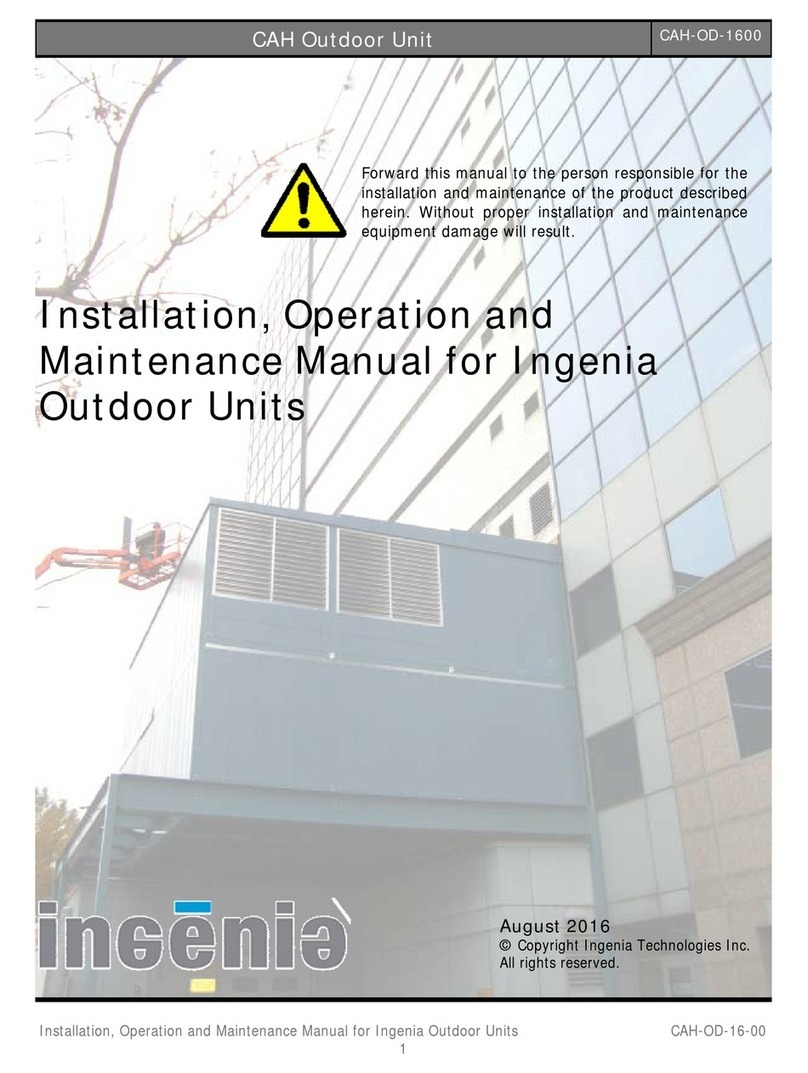
INGENIA
INGENIA CAH Installation, operation and maintenance manual
